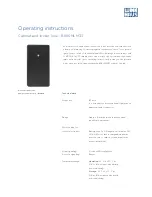
The furniture handle supplied can be used to close an existing duct with a
back plate (18 or 24 mm included in the delivery) on the front plate of furni-
ture and simultaneously serves as an opening aid on the door. Further de-
tails on the mechanical connection of the M33 system to your furniture can
be found in the installation instructions of your furniture manufacturer. If you
have any questions on installing the system, consult a carpentry specialist or
your supplier before conducting the installation.
Only mount the furniture lock into the piece of furniture
when it is unlocked. Use type LR6 AA alkaline batteries only.
Make sure the polarity is correct! Rechargeable, zinc-carbon
or lithium batteries are not permitted!
Conducting an emergency opening:
If the batteries in the lock unit are empty and an emergency open-
ing will have to be informed, please use the micro USB power adapter
(Item no.: 5046900). To do so, remove the USB plugs on the bottom of the
reader unit and connect the power adapter to the reader unit using the en-
closed cable. You will then be able to open the cabinet with an authorised
identification medium after 10 seconds at most. Please change the batteries
of the lock housing at once.
Visual and acoustic indicators:
LED red
LED green
Acoustic signal
Authorised key opening
The signal is made after the authentication check has been con-
ducted and the release position has been reached.
1x 300 ms
Authorised key closing
The signal is made after the authentication check has been con-
ducted.
1x 300 ms
Unauthorised key
The signal is made after the authentication check has been con-
ducted.
1x 750 ms
Triggering without key
This signal is given if the electronics are triggered by an external
125 kHz signal or by an oscillating circuit, but no valid key data
can be read after approx. 270 ms. This makes it possible to detect
unintentional triggering of the electronics in an environment prone
to interference which could cause a battery discharge or other
malfunctions (when reading a key, for example).
1x 8 ms
Release position cannot be reached
This signal will be given if the dead bolt does not reach the release
position (e.g. deadbolt blocked, fouling).
10x 50 ms
Locking position cannot be reached
This signal will be given if the dead bolt does not reach the locking
position (e.g. deadbolt blocked, fouling). If communication to the
motor unit is interrupted, the operation will be aborted after the
signal. Otherwise, it will attempt to engage in locking position again
after a few seconds. If the first attempt is successful, the operation
will end, otherwise the operation will be repeated up to five times.
After that, up to two “secret attempts” (without signalling) for mo-
tor activation will follow at an interval of 60 s. An activation attempt
will also occur if a key is detected during this time.
10x 50 ms
























